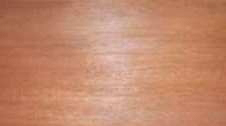 TATAJUBA
TATAJUBA

Botanical name: Bagassa guianensis
Family: Moraceae
Other Common Names: Cow-wood (Guyana), Gele bagasse (Surinam), Bagasse jaune (French Guiana), Tatajuba, Amapa-rana (Brazil).
Distribution: Rather infrequent occurrence in the Guianas and the Brazilian Amazon.
The Tree: A large, well-formed, unbuttressed canopy tree with a flat, umbrella-shaped crown. The trees are generally 20 to 24 in. in diameter, and 90 to 100 ft in height. The bole is cylindrical and 60 to 70 ft high. Bark, when cut, yields large quantities a sweet, sticky latex.
The Wood:
General Characteristics: Unseasoned heartwood is yellow, often streaked with brown, becoming lustrous golden-brown to russet on exposure. Sapwood is narrow, sharply demarcated, pale yellow to yellowish white. Grain usually interlocked resulting in rather broad stripe; texture medium to coarse, moderately uniform; odor and taste not distinctive when seasoned.
Weight: Basic specific gravity (ovendry weight/green volume) averages 0.68. Air- dry density averages 50 pcf.
Mechanical Properties: (2-in. standard)
Moisture content Bending strength Modulus of elasticity Maximum crushing strength
(%) (Psi) (1,000 psi) (Psi)
Green (74) 14,510 2,300 7,900
12% 20,050 2,580 11,560
Janka side hardness 1,670 lb for green wood and 1,730 lb for dry.
Drying and Shrinkage: The wood air-seasons at a moderate rate with very little tendency to warp or check. No kiln schedules are available. Shrinkage green to ovendry: radial 5.2%; tangential 6.6%; volumetric 10.2%. Volumetric shrinkage is exceptionally low for a wood of this density.
Working Properties: Easy to saw and finishes smoothly.
Durability: Heartwood is reported to be very durable when exposed to either white-rot or brown-rot fungi; slightly resistant to marine borers. Weathering characteristics are considered poor.
Preservation: Heartwood is highly resistant to moisture absorption, comparable to teak in this respect, suggesting poor treatability.
Uses: Wood used locally for general building purposes, heavy construction, furniture, boat construction. Because of its high resilience, it may be suitable for some type of sporting equipment. Wood is similar to black locust and could be used as a substitute for some applications.







